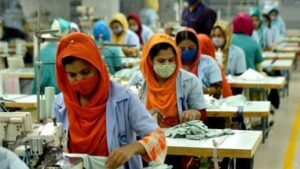 Although an increasing number of female students are coming out of universities every year, they continue to have the highest unemployment rate among graduates, according to the Labour Force Survey (LFS) 2022 released at the end of last week.
Although an increasing number of female students are coming out of universities every year, they continue to have the highest unemployment rate among graduates, according to the Labour Force Survey (LFS) 2022 released at the end of last week.
Out of around eight lakh graduates seeking jobs, 3.36 lakh females were jobless in 2022.
The unemployment rate among female graduates was 18.88 percent, which was higher than the overall jobless rate of 12 percent among people with higher education, showed the LFS data by the Bangladesh Bureau of Statistics (BBS).
Analysts blamed a lack of job opportunities, conducive work environment and adverse social attitudes for the high rate of unemployment among women with higher education.
“We could not increase investment in institutional support for educated female workers yet,” said Prof Sharmind Neelormi, who teaches economics at Jahangirnagar University.
Usually, female graduates want to join a flexible job that provides a conducive environment with the support of their families, she added.
“The country is now producing a huge number of graduates without ensuring enough jobs for them.”
There is no alternative to proper planning on how to utilise graduates according to their potential, she suggested.
The LFS data showed that the unemployment rate among female graduates declined in 2022 from 21.4 percent five years ago thanks to a reduction in jobless rate among women with higher secondary education in rural areas.
However, the unemployment rate among female graduates in urban areas rose to 19.17 percent.
Prof Dil Afroza Begum, former member of the University Grants Commission (UGC) of Bangladesh, said the tendency to look for jobs among female graduates fell after marriage.
“It’s a social and family-driven problem,” she said.
She said most married women could not work due to family pressure unless they held a government job.
She also pointed to a gap between technical literacy and job expectations.
A graduate female worker does not prefer to join a low-profile job. At the same time, recruiters do not find proper technical expertise among female graduates, she said.
Meanwhile, the women labour force participation rate has risen to 42.77 percent in 2022 from 36.3 percent five years ago.
“Although the women labour force participation rate has increased in 2022, it happened only in rural areas,” said Prof Selim Raihan, executive director of the South Asian Network on Economic Modeling (Sanem).
We have found increasing female employment in agriculture instead of the non-farming sector, he said.
Most of them are unpaid female workers doing this work as a domestic chore in the absence of their husbands, he added.
It may be a reflection of an economic slowdown and post-Covid-19 shock, he said of the higher unemployment rate among female graduates.
Between 2017 and 2022, new jobs were not created on the required scale and those who lost their jobs did not find alternate employment in the post-Covid period, he added.
“Taking such issues into account, job opportunities have shrunk in urban areas,” he said.
Soma Day, associate professor of the women and gender studies department at the University of Dhaka, echoed Prof Raihan’s sentiments about the job shortage in the service sector and formal sector.
Female graduates’ participation has increased in informal sectors such as agriculture, she said, adding that a number of female students were enrolling every year to take higher education but could not be found in the professional workforce.
“The lack of quality jobs and taking on reproductive roles are working as driving forces behind their dwindling participation in the workforce,” she said.
Workplaces still could not still provide them with child-caring facilities, she added.
“At other times, in-laws treat the female’s higher education as a simple measure of a presentable bride,” she said.
Binayak Sen, director-general of the Bangladesh Institute of Development Studies, welcomed the drastic fall in rural unemployed graduates.
“It indicates that rural women have participated in the workforce thanks to the presence of NGOs and other organisations,” Sen told The Daily Star recently.









